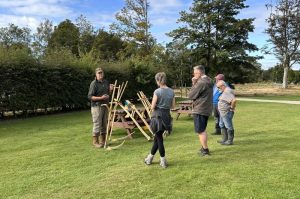Other tools and resources
There are lots of general tools and resources about wildlife gardening. We’ve tried to bring them all together to help.
Useful meadow creation and grassland management links
Some links to websites with advice and information on meadow and grassland management and creation. Included a list of recommendations for people interested in scything their grassland. Recommended by our local scything trainer.
Advice on grassland management from TCV
Plantlife meadow advice
Buglife Pollinator advice and B-Lines
Native seed and plant advice
- Scottish origin seeds and advice notes from Scotia Seeds
- Wild flower plug plants of local North East Scotland origin and planting advice
- Growing local wildflowers in NE Scotland seed collecting and sowing
Scything equipment and useful links
- Simon Fairlie’s shop – Along with Peter Vido (see below) Simon is responsible for the upsurge of interest in scything in the UK.
Scythe Cymru shop – NESBiP’s scythes were purchased from here.
Steve Tomlin, scythe tuition – Steve’s book “Learn to Scythe” is a good resource to start with. It covers the basics of what kit to get, choice of blade, how to peen and sharpen and how to mow. - Scythe Connection – Useful information and resources, site was started by the late Peter Vido, who was largely responsible for introducing the European style scythe to North America and the UK, and who started the resurgence of interest in scything.
Our local scything trainer, Doug Gooday, preference for end of season mowing of wildlife meadows to be either the 65cm Styria Ditch blade or a 60 or 70 cm Raiserschnitt. These blades cope well with the end of season tougher grasses and woody wildflower stems in August and September. He believes that the blades sold as ‘meadow’ blades, such as the Luxor and Profisense, are suited to summer hay meadows, where the grasses are lush and still soft and green and where the objective is to produce soft, nutritious hay for fodder.
Caring for newly planted trees
Every year, hundreds of thousands of trees are planted around the UK, but for them to stand the best chance of surviving, they will need some basic aftercare.
Those involved in planting have a vital role to play in this next stage. Simple actions such as weeding, watering, and checking guards, stakes and ties at key times can significantly improve a tree’s chances of successful establishment.
This guide provides detailed information on the care and maintenance of newly planted trees to enhance their survival and growth.
Caring-for-newly-planted-trees-2025.pdf
Community Climate Adaptation Routemap
The Community Climate Adaptation Routemap is a practical guide to help communities adapt to climate change. No matter what kind of community you are, there are actions you can take to build resilience, prepare for climate change, and make your area healthier, safer, and more comfortable for people and wildlife.
This Routemap offers clear steps for local action groups, community councils, and development trusts to build their resilience to climate change.
We are the ARK
We are the ARK (Acts of Restorative Kindness) is an initiative founded by Mary Reynolds. It aims to raise awareness of the extinction event we are experiencing, create safe and abundant havens for wildlife, give as much land as possible back to nature and create a web of interconnected living sanctuaries that will become the seeds to restore biodiversity. The interconnected living sanctuaries are known as an Ark.
You can find information on how to build your own Ark here: BUILD AN ARK | We Are The Ark.
The Wildlife Trust resources
- Wild about lawns – Bring your lawn to life
- Greener Gardening – Perfecting peat-free
- Making Friends with molluscs – Garden with slugs and snails
- Get creative for Hedgehogs – Small step everyone can take together to help save the hedgehog
- Bring back our beetles – Discover the UK’s beetles and how you can help them
- Go wild for worms – Worms make the world turn, welcome them to your garden
- Your wild bee action pack – Get your garden buzzing for bees
Butterfly Conservation
- Moon Meadows – Discover how to create a moon meadow to help our struggling moths
- Wild Spaces – Help our struggling butterflies by creating a wild space
- Food plants for butterfly caterpillars – Caterpillars need to eat, try planting species that butterflies will lay their eggs on
- Food plants for moth caterpillars – Try planting species that moths will lay their eggs on
- Gardening for Butterflies leaflet – Learn how to garden for butterflies
Greenspace Aberdeenshire
A greenspace is any area of land or water within or next to an urban area. This can include parks, playing fields, play areas, natural and wild areas, woodlands, food growing areas and cemeteries. They play an important part in improving the variety of plants and animals in Aberdeenshire and help strengthen communities.
Greenspace Aberdeenshire is a project that aims to provide a new approach to the creation and care of Aberdeenshire Council owned and managed greenspaces through local community involvement.
You can learn more about how they are managing their greenspaces for people and wildlife from their website: Greenspace biodiversity – Aberdeenshire Council.
The Greenspace Officers have suggested lists of flowers and plants for use in urban community planting. These include plants for containers, baskets and borders.

Example of taking an ecosystem approach to gardening – a wildlife pond.

Doug Gooday, Scything trainer, delivering a scything workshop at Aden Country Park

